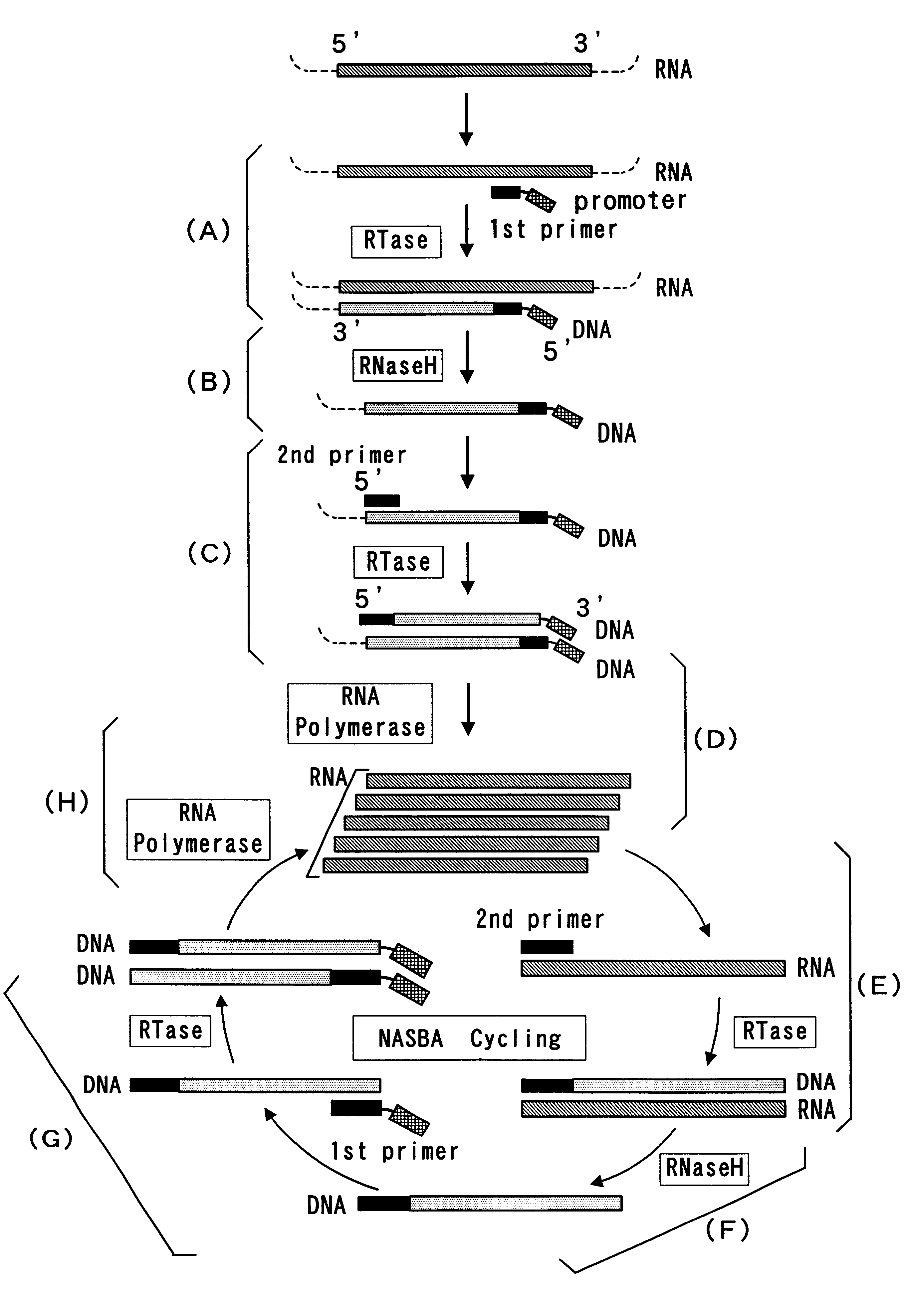Reagent for nucleic acid amplification and process for nucleic acid amplification
a nucleic acid amplification and process technology, applied in the field of nucleic acid amplification reagents and nucleic acid amplification processes, can solve the problems of non-specific amplification reactions, contaminated amplification products, and troublesome manipulation of rt-pcr, so as to improve the detection sensitivity of conventional detection techniques, improve the detection sensitivity, and increase the positive signal.
- Summary
- Abstract
- Description
- Claims
- Application Information
AI Technical Summary
Benefits of technology
Problems solved by technology
Method used
Image
Examples
example 1
Amplification of Mycobacterium tuberculosis 16S rRNA using amplification reaction mixture containing EDTA, and detection of amplified RNA
(1) Synthesis of DNA primers for amplification of Mycobacterium tuberculosis 16S rRNA
An oligonucleotide of SEQ. ID. NO. 1 (a reverse primer for amplification of Mycobacterium tuberculosis 16S rRNA; hereinafter referred to as Primer 1) and an oligonucleotide of SEQ. ID. NO. 2 (a forward primer for amplification of Mycobacterium tuberculosis 16S rRNA; hereinafter referred to as Primer 2) were synthesized by the phosphoamidite method using DNA Synthesizer Model 392 (Perkin-Elmer).
Primer 1 had at its 3' end a DNA sequence (20 nucleotides) complementary to a 3' end sequence of the target RNA, and had a T7 promoter sequence (27 nucleotides) attached to its 5' end. Primer 2 had a DNA sequence (21 nucleotides) homologous to a 5' end sequence of the target RNA.
These oligonucleotides were synthesized according to the manufacture's instructions on the synthes...
example 2
Mycobacterium tuberculosis 16S rRNA (initial concentration: 10 pg / .mu.l) was amplified and detected in the same manner as in Example 1 except for using EDTA-Na at concentrations shown in Table 2 (0 to 80 mM). As a control test, the amplification reaction was carried out using distilled water in place of Mycobacterium tuberculosis 16S rRNA to test the influence of EDTA-Na on the detection. The results are shown in Table 2, wherein the numeric values indicate luminescence quantities (cps, count / second).
As apparent from Table 2, addition of EDTA-Na at any concentration (3 to 80 mM) remarkably increases the positive signal, as compared with the positive signal obtained without using EDTA-Na. The results of the control test reveal that the luminescence quantity from the control sample is not increased by addition of EDTA-Na, demonstrating that EDTA-Na does not affect the detection.
example 3
Amplification of Mycobacterium tuberculosis 16S rRNA using amplification reaction mixture containing NTA, and detection of amplified RNA
(1) NASBA of Mycobacterium tuberculosis 16S rRNA
Mycobacterium tuberculosis 16S rRNA was amplified using the same reagent and following the same procedure as in Example 1 except for adding NTA-Na, in place of EDTA, to the amplification reaction mixture. The amplified RNA was subjected to sandwich hybridization on a microtiter plate by the method (7) in Example 1 to test the signal enhancing effect of NTA.
(2) Results (effect of addition of NTA-Na in the presence of negative RNA (10 ng / .mu.l yeast RNA))
The results of (1) are shown in Table 3 (n=4), wherein the numeric values indicate the luminescence quantities (cps, count / second).
As apparent from the above results, addition of NTA-Na to the amplification reaction mixture remarkably increases the luminescence quantity (positive signal). That is, addition of 1.5 mM NTA-Na increases the luminescence quan...
PUM
| Property | Measurement | Unit |
|---|---|---|
| time | aaaaa | aaaaa |
| temperature | aaaaa | aaaaa |
| pH | aaaaa | aaaaa |
Abstract
Description
Claims
Application Information
 Login to View More
Login to View More - R&D
- Intellectual Property
- Life Sciences
- Materials
- Tech Scout
- Unparalleled Data Quality
- Higher Quality Content
- 60% Fewer Hallucinations
Browse by: Latest US Patents, China's latest patents, Technical Efficacy Thesaurus, Application Domain, Technology Topic, Popular Technical Reports.
© 2025 PatSnap. All rights reserved.Legal|Privacy policy|Modern Slavery Act Transparency Statement|Sitemap|About US| Contact US: help@patsnap.com


